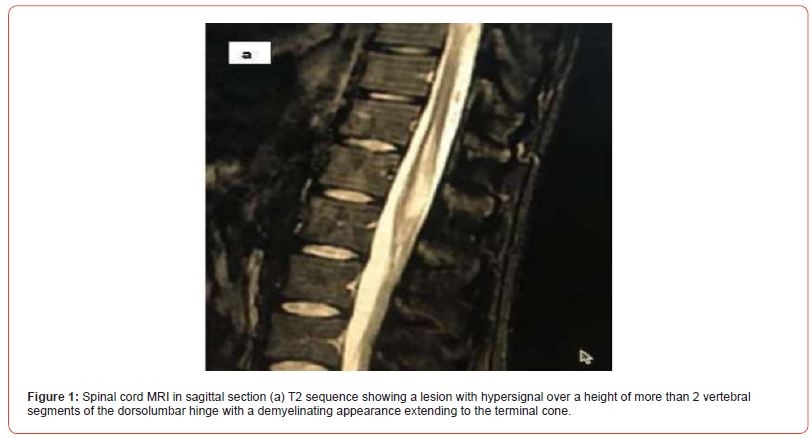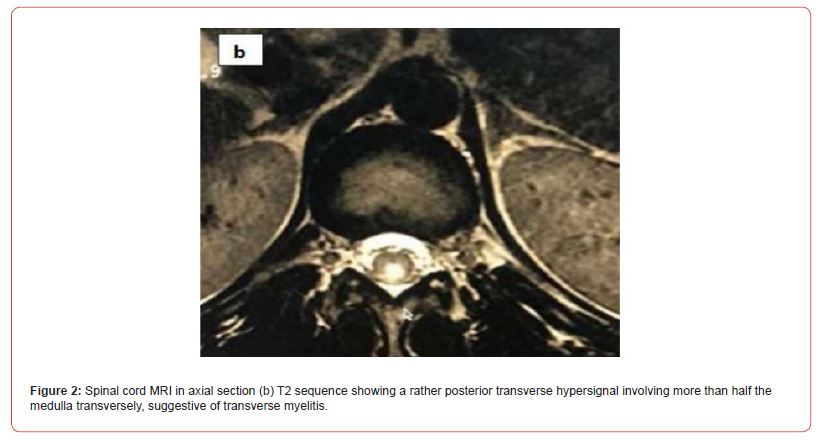 Case Report
Case Report
Acute Transverse Myelitis Post-Vaccine Covid 19 as A Revealing Mode of NMOSD: A Case Report
Alloussi Houda*, Adraoui Yassine, Aziz Ahizoun, Youssouf Benmoh, Mouloudi Najoua, and Bourazza Ahmed
Department of Neurology and Neurophysiology, Military Hospital Mohammed V Rabat, Morocco
Alloussi Houda, Department of Neurology and Neurophysiology, Military Hospital Mohammed V Rabat, Morocco.
Received Date: August 04,2023; Published Date: August 31, 2023
Abstract
After the word pandemic Sarscov2 and the advent of covid 19 vaccination, a wide range of neurological complications are continually being reported; we illustrate the clinical case of a 21-year-old man, who was admitted for a spinal cord syndrome with D12-L1 sensory level two weeks after vaccination covid 19 and was diagnosed with acute transverse myelitis associated with positives antibodies AQP4. Our case presents a temporal association with covid 19 vaccination demonstrated by the onset of symptoms after the 1st dose and the worsening of symptoms after the administration of the 2nd dose. After review of the literature, four cases of NMOSD have been reported in post-vaccination; We suggest that our case is the fifth.
Introduction
The advent of covid 19 vaccination has brought a glimmer of hope to combat the deadly global SARS-COV2 pandemic. However ; many neurological complications are continually being reported ; these are generally mild and transient but others more severe such as demyelinating diseases of the central and peripheral nervous system. In this observation, we report the case of a patient admitted acute post-vaccination transverse myelitis revealing a case of neuromyelitis optica spectrum disorder (NMOSD).
Case report
A 21-year-old patient, his past medical history was unremarkable, presented to the emergency department with subacute total functional impotence of the lower limbs ; the patient having presented one week after the 1st dose of covid 19 vaccine with pares thesias of the lower limbs of the tingling and numbness type, aggravated two weeks later after administration of the 2nd dose by heaviness of both lower limbs associated with sphincter disorders ; urinary incontinence and constipation. Neurological examination on admission revealed flaccid paraplegia with superficial and thermoalgesic anaesthesia in the lower limbs, with sensory level D12-L1. The rest of the physical examination was unremarkable. MRI of the spinal cord was performed ; revealing a demyelinating lesion of the dorsolumbar hinge extending to the terminal cone, with heterogeneous enhancement in places after contrast-medium administration, suggestive of transverse myelitis (Figures 1 and 2) ; the brain MRI was normal, the lumbar puncture was unremarkable. Routine laboratories were within normal limits, including complete blood count, electrolytes, kidney, liver functions, vitamin B12 and folic acid (Figures 1 & 2).


Accessory salivary gland biopsy was performed with no abnormalities, as were HIV and syphilis serologies. The immunological work-up revealed positive anti-NMO, anti-TPO and anti-TGO ACs, with euthyroidism on thyroid hormone assay and a cervical ultrasound without abnormalities. We decided to administer an initial bolus corticosteroid at (1g/day) during 5 days, followed by oral corticosteroid, with good clinical evolution in terms of motor and sensory function. The patient had gradually recovered his deficit, with unassisted walking possible, and sphincter disorders disappeared after one month. Given the clinical, biological and radiological criteria, the diagnosis of NMOSD was made and the patient received Rituximab 1g on Day 1 and 1g Day 15, then 1g every 6 months with Prior anti-CD19 assay.
Discussion
NMO is a humoral-mediated auto-immune disease characterized radiologically by optic neuritis and/or long-segment transverse myelitis, as well as by a characteristic distribution of signal abnormalities on cerebral MRI ; AQP4 is a specific antibody seen in NMO patients that binds specifically to AQP4 water channels that are highly expressed in specific areas of the brain, including the ependymal surfaces of the ventricles, corpus callosum, corticospinal tract and periaqueductal region [1].
Although the most common demyelinating disease after vaccination is acute disseminated encephalomyelitis, a number of cases of neuromyelitis optica spectrum disorder (NMOSD) have been reported in the literature following exposure to various vaccines, and rare cases after covid 19 vaccination [2].
After review of the literature, 4 cases of NMOSD have been reported post-vaccination, including two cases of acute transverse myelitis with notion of co-existing autoimmunity, one case of post-rema area syndrome and one case of encephalopathy [3, 4]. We suggest that our case is the 5th.
The relationship between vaccination and demyelinating diseases has been frequently cited in the literature, with no clear evidence of causality apart from temporal association ; Our case presents a temporal association with covid 19 vaccination demonstrated by the onset of symptoms after 1st dose and worsening of the clinical picture after administration of the 2nd dose. Several studies have suggested that vaccines May trigger, exacerbate or even cause demyelinating events in the nervous system; the pathophysiology behind this potential link is not fully known, but several theories have been proposed. One theory suggests that molecular mimicry (cross-reactivity between vaccine antigens and myelin proteins) could trigger auto-immune demyelination. Another theory proposes that, as upper respiratory tract and other infections are known risk factors for relapsing multiple sclerosis, vaccines could increase the risk of central nervous system demyelination through a similar infection-induced mechanism. Some of the specific mechanisms involved in pathogenesis include expansion and stimulation of self-reactive T-cell clones, enhanced antigen presentation and epitope propagation [2]. Systemic autoantibodies and Systemic autoantibodies and systemic auto-immune diseases could coexist with NMOSD. In the present case, auto-immune antibodies had not been tested Prior to vaccination ; thus we could not determine whether she had a systemic auto-immune background in the Past. In other words, it is unclear whether the vaccine merely induces or directly causes NMOSD [5].
Conclusion
The scientific Community and the public are increasingly concerned about the side effects of various vaccines, and in particular covid 19 vaccines, as the world has been faced with the largest mass vaccination Campaign in history, so cases of demyelination Will inevitably occur, either directly after vaccination or by chance. Although association does not always imply causality, long-term post-marketing surveillance of demyelination cases is warranted, in order to assess causality.
Acknowledgement
None.
Conflicts of Interest
The authors do not declare any conflicts of interest.
References
- Bruna Garbugio Dutra, Antônio José da Rocha, Renato Hoffmann Nunes, Antônio Carlos Martins Maia (2018) Neuromyelitis optica spectrum disorders : spectrum of MR imaging findings and their differential diagnosis. Radio Graphics. 38(1): 169-193.
- Neha Kumar, Kelsey Graven, Nancy I Joseph, John Johnson, Scott Fulton and et al. (2020) Case Report: Postvaccination Anti-Myelin Oligodendrocyte Glycoprotein Neuromyelitis Optica Spectrum Disorder: A Case Report and Literature Review of Postvaccination Demyelination. Int J MS Care. 22(2): 85-90.
- Noor Badrawi, Navin Kumar, Usama Albastaki Post (2021) COVID-19 vaccination neuromyelitis optica spectrum disorder: Case report & MRI findings. Radiol Case Rep. 16(12): 3864-3867.
- Ismail Ibrahim Ismail, Sara Salama (2022) A systematic review of cases of CNS demyelination following COVID-19 vaccination. Journal of neuroimmunology, 362: 577765.
- l Panayiotis G Vlachoyiannopoulos, Eleni Magira, Haris Alexopoulos, Edison Jahaj, Katerina Theophilopoulou and et al. (2020) Autoantibodies related to systemic autoimmune rheumatic diseases in severely ill patients with COVID-19. Ann Rheum Dis. 79(12) :1661-1663.
-
Alloussi Houda*, Adraoui Yassine, Aziz Ahizoun, Youssouf Benmoh, Mouloudi Najoua, and Bourazza Ahmed. Acute Transverse Myelitis Post-Vaccine Covid 19 as A Revealing Mode of NMOSD: A Case Report. Arch Neurol & Neurosci. 15(5): 2023. ANN.MS.ID.000872.
-
Brain Disorders. Nerves, Psychology, Spinal Cord, Neuropathies, Anorexia Nervosa, vertigo, Hyperactivity Disorder, Seizure, Mental Health, Nervous System, Cortex, Dementia, Multiple , sclerosis, Cognitive neuroscience, Schizophrenia, Concussion, Alzheimer’s, Dementia, Depression, Motor , neurone Disease, Parkinson’s, Stroke, Addiction, Neurodegenerative Diseases, Consciousness, Dyslexia, Brain Disorders, Traumatic Stress Disorder, Migraine, Epilepsy, Hypertension, Anxiety, Sleep Disorders Autism, Aneurysm.
-

This work is licensed under a Creative Commons Attribution-NonCommercial 4.0 International License.






